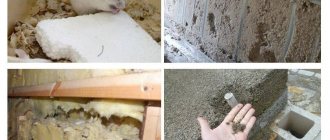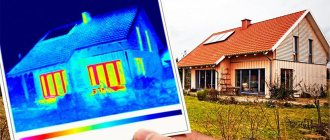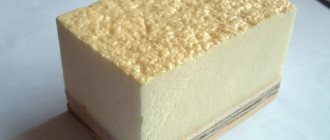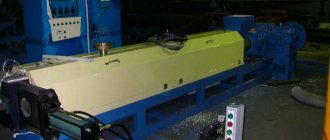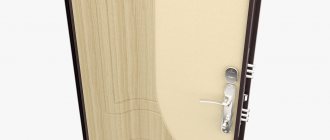Types of foam glass
In individual and urban planning, two types of this insulation are used:
- Block foam glass - has the shape of plates and a cellular structure. Used for thermal insulation of basements, facades, blind areas, interfloor ceilings, foundations, pipelines, and ceilings. The slab does not shrink, so it can be used as a base building material.
- Granular foam glass - has the shape of small granules in the form of a sphere, or resembles the shape of gravel or sand. Fraction sizes range from 1 to 20 mm. Used for thermal insulation of interior walls, ceilings and floors.
Despite the differences in areas of use and production technology, both forms of material provide high-quality insulation and have the same technical characteristics.
Claim
1. A method for producing foam glass, including preparing a composition for producing foam glass by jointly grinding a carbonate salt with a finely ground glass charge, obtaining a composition in the form of an aqueous suspension, followed by drying, foaming and heat treatment, characterized in that when jointly grinding with a finely ground glass charge, a mixture of carbonate is used calcium with kaolin, an aqueous suspension with a concentration of 10-30% is obtained by spraying an aqueous solution of sodium nitrate and soluble glass onto the surface of a jointly crushed glass charge, calcium carbonate and kaolin with constant stirring in a turboblade granulator-mixer, drying the resulting aqueous suspension is carried out in a drum dryer until residual humidity 5.0-6.6%.
2. The method according to claim 1, characterized in that the composition is foamed on a continuous conveyor belt moving at a speed of 5-20 m/h, after which it is cut into blocks at a temperature of 600-700°C.
3. The method according to claim 1, characterized in that foaming is carried out in tube furnaces at a temperature of 850-950°C.
4. The method according to claim 1, characterized in that the composition for producing foam glass after drying in a drum dryer is a mixture of granules with a size of 300-500 microns.
5. Composition for foam glass obtained according to claims 1-4, including finely ground glass charge, a foaming mixture based on carbonate salt, soluble glass and water, characterized in that it additionally contains sodium nitrate and kaolin in the following ratio of components, parts by weight. :
| Finely ground glass batch | 100 |
| Calcium carbonate | 0,5-2,0 |
| Kaolin | 0,1-1,0 |
| Sodium nitrate | 0,5-3,0 |
| Soluble glass | 5,0-15,0 |
| Water | 5,0-6,6 |
6. The composition according to claim 5, characterized in that the specific surface area of the finely ground glass batch is 5000-7000 cm2/g.
7. Composition according to claim 5, characterized in that calcium carbonate is a product of natural origin.
Features of plate production
Foam glass is produced in two forms - blocks and granules. The main raw materials are obtained from broken bottle and window glass. This allows the use of technology for recycling raw materials, since glass takes a long time to decompose.
After cleaning and sorting, the broken glass is crushed to a powder state. To foam, carbon is added to the fraction and the mixture is heated to a thousand degrees. At this temperature, the gas evaporates and the glass melt foams.
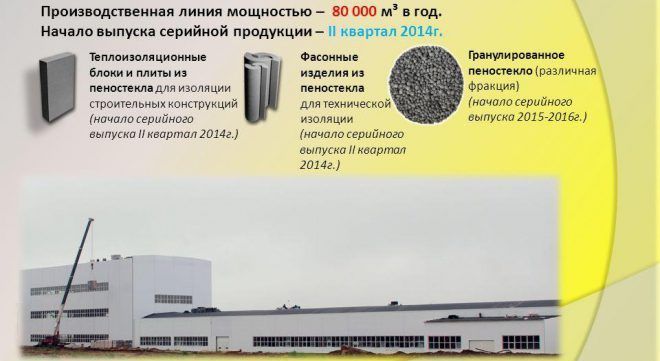
The heated glass mass is a viscous mixture, which, after being removed from the furnace, hardens and is fired.
Thus, the technological scheme from raw materials to the finished product contains:
- Glass cleaning;
- Sorting of raw materials;
- Melting glass melt;
- Gas passing;
- Cooling;
- Firing the finished slab.

[ads-pc-3]
Types of foam glass and its properties
Foam glass is produced in 2 types: blocks and granules.
The blocks typically range from 200 to 600 mm in length, 125 to 400 mm in width and 60 to 120 mm in thickness.

Granular material has the form of rounded granules of various fractions and is used for heat-insulating backfill of roofs, floors, external walls and partitions. They are often also used as a filler in warm plaster and masonry mortars.
The technical characteristics of the material are as follows:
- density - from 120 to 200 kg/cubic. m;
- thermal conductivity – from 0.04 to 0.08 W/(mK);
- compressive strength - from 0.7 to 4 MPa;
- bending strength – from 0.4 to 0.6 MPa;
- vapor permeability – from 0 to 0.005 (m.h.Pa);
- sorption humidity – from 0.2 to 0.5%;
- water absorption from 0 to 5% of volume
- noise reduction – up to 56 dB;
- the temperature at which the deformation process begins is 450 degrees;
- operating temperature range – from -200 to +500 degrees.
Material properties
Thanks to these characteristics, the material has the property of durability.
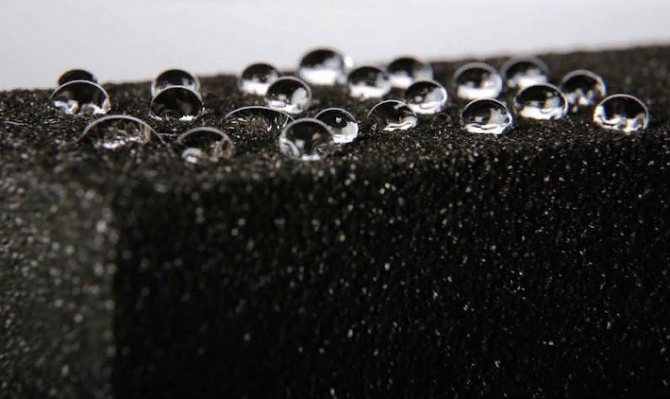
The service life of the blocks, while maintaining their original characteristics, exceeds 100 years, which is comparable to the service life of a building. This is due to the fact that the material resists such active factors that appear over time, such as:
- oxidation - atmospheric oxygen cannot even to a small extent affect the oxides that make up glass;
- erosion is impossible due to the fact that the material contains no soluble components;
- biological factors - foam glass does not contain the nutrient media necessary for the development of mold, mildew or bacteria, and is also not destroyed by plant roots;
- freezing – the material consists of closed cells that prevent moisture from entering;
- deformation - the material does not deform at all, therefore it does not shrink or sag;
- strength – foam glass is the strongest of the most effective insulation materials (its compressive strength is several times higher than that of foam plastic or fibrous materials);
- resistance to chemicals (except hydrofluoric acid);
- stability of physical characteristics;
- foam glass is an impenetrable barrier for insects and rodents;
- fire resistance and non-combustibility;
- moisture resistance is due to the tightness of the cells, the walls of which do not allow water to pass through;
- the environmental friendliness and safety of the material allow it to be used for medical and food buildings;
- ease of processing, ability to stick together when used, bitumen, glue or any type of building mixture.
Pellet production
[ads-pc-4]
The manufacturing technology of granular foam glass is somewhat different. After cleaning and sorting the raw materials, they undergo the following processing:
- Melting at high temperatures;
- Pouring into rounded billets;
- Foaming in a rotary kiln;
- Cooling and firing of finished granules.
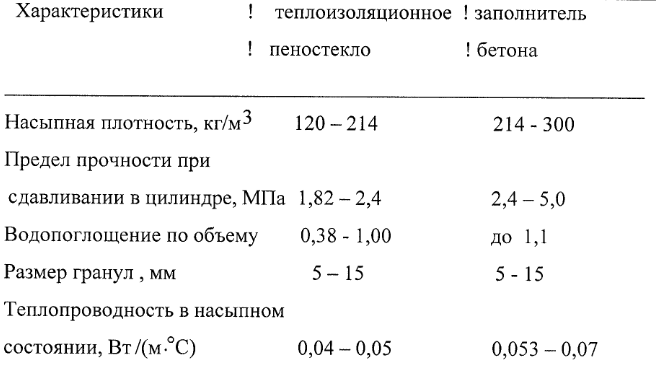
Granulated foam glass is 15 times larger in volume than the raw material taken. You should also distinguish insulation from liquid glass, which is produced at lower temperatures by quickly removing water and gaseous substances. Liquid glass is not an insulator and is unstable even when exposed to water.
Specifications
Despite the rigidity of the material, it has a fairly low thermal conductivity, which means good thermal insulation performance. Main characteristics of foam glass:
- The thermal conductivity of the material is 0.04 W/m*s. Compared to wood, the thermal conductivity of foam glass is two times lower, and its thermal insulation properties are two times better. The thermal conductivity of mineral wool, which is popular in insulation, is thirty percent higher. Such performance of foam glass is due to its cellular structure.
- Temperature stability. The plate is able to withstand a maximum temperature of 300 °C without deformation or destruction of the material. During the production process, substances can be added to the glass melt to triple the heat resistance. The lowest limiting temperature at which material destruction does not occur is -200°C.
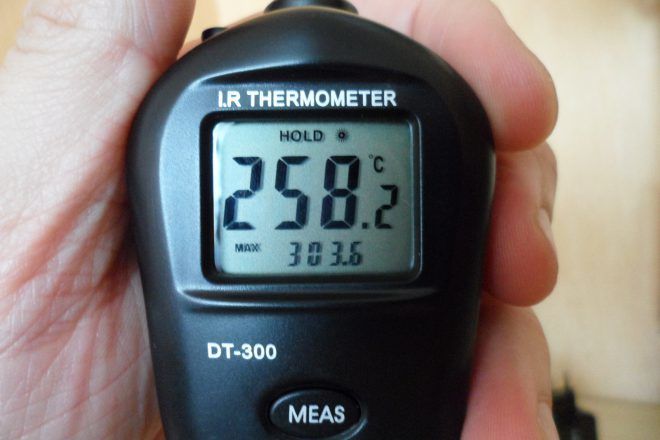
- Strength of the material. Per square meter, the material can withstand a load of 40 to 100 tons or 0.5-1.2 MPa. During operation, this parameter does not change. But in terms of impact strength, the material is somewhat inferior to its analogues, since it can be broken by the application of mechanical force.
- The density of foam glass ranges from 100 to 250 kg/m3. For comparison, dry wood has a density of 550 to 750 kg/m3.
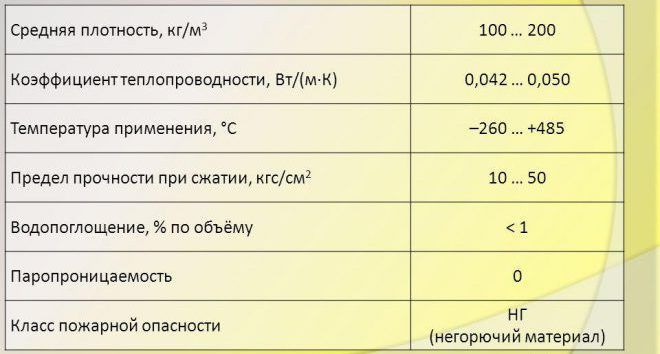
- The sound insulation of the material is comparable to that of mineral wool - foam glass copes with sound waves of 45-56 dB.
- The vapor permeability of the material is 0.005 mg/(m*h*Pa), which allows the use of foam glass as a vapor barrier.
- The moisture resistance of the blocks is equal to two percent of the volume of the block; the material itself does not interact with water and does not deform under its influence.
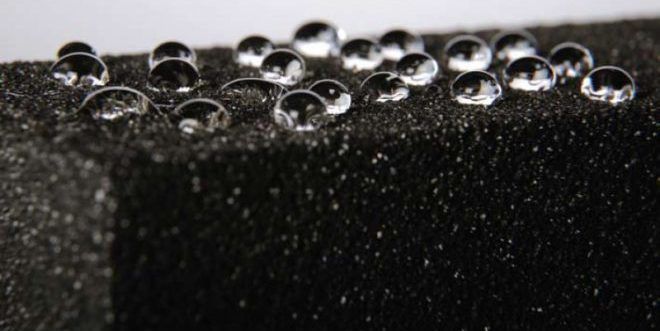
- The chemical resistance of foam glass has been found in relation to acids, alkalis, gases and oil products, as well as construction mixtures. It is deformed only under the influence of hydrofluoric acid, which is practically not used in everyday life due to its high toxicity.
- The biological resistance of foam glass to insects, rodents and fungal colonies is quite high, which gives it an advantage over other insulation materials.
- The material does not burn and does not emit toxic gases, and its composition does not contain substances that are harmful to the human body, therefore it is considered quite environmentally friendly.
[ads-pc-2]
Foam glass. Traditional and new technologies
Back in the 30s of the 20th century, Soviet academician I. I. Kitaigorodsky created a new material based on the special property of silicate glasses - at temperatures of about 1000 ° C in the presence of a gas generator, they soften and foam. Cooled glass melt is very strong and resistant to mechanical stress.
Scientists, when developing this material, intended to use mainly its buoyancy, but it turned out that foam glass has excellent heat-insulating and sound-proofing properties. The use of this material as a heat insulator began in the 40s in Canada, and became widespread in Europe and America. In the USSR, foam glass was not so widely used, since its production was not developed, and the material had a high cost.

In recent years, the production of foam glass has begun to actively develop, because this material has unique properties and performance characteristics that are superior to other insulating materials. First of all, foam glass is an absolutely environmentally friendly material that does not emit harmful substances even when exposed to high temperatures. The temperature resistance is very high; foam glass does not burn and can withstand heating up to 600°C. Foam glass is not subject to destruction throughout its entire service life, it does not crumble, is not saturated with moisture and is not subject to corrosion.
Foam glass is a completely inorganic material, therefore, when using it in the construction of a country cottage, you do not have to be afraid that it will be destroyed by rats, insects or microorganisms. With its high strength, this material lends itself well to mechanical processing and can be given any shape. Installation of foam glass is also not a problem; it can be attached using any modern building mixtures. Since foam glass is a lightweight material, the weight of the entire building, and, consequently, the pressure on the foundation, is reduced, and construction becomes more economical.
The high compressive strength inherent in foam glass also helps to reduce the cost and speed up construction, as it makes it possible to avoid reinforced ties when installing floors, to reduce unloading belts when arranging facades, etc.
Foam glass is produced in the form of blocks, granules and crushed stone; the scope of application of these types of foam glass varies slightly. The blocks can be used as thermal insulation in the construction of walls, roofs, basements, as well as in the construction of pipelines. Foam glass blocks serve as excellent protection for granaries and can act as fire-barrier structures. Granules are used as backfill insulation and filler for lightweight concrete. Crushed stone can be used in the same way as foam glass granules in road construction.
The raw materials used for the production of foam glass are rocks such as trachyte, syenite, nepheline, obsidian, volcanic tuff, as well as ordinary glass waste, that is, cullet generated during the production of sheet, container, electrical glass, and crystal products.
Foam glass ceramics
The development of technology and the use of innovative solutions made it possible to develop a process for manufacturing foam glass without the use of expensive cullet, and, accordingly, to exclude grinding operations from the technological process. The new technology involves the use of inexpensive raw materials - siliceous rocks such as diatomite, opoka, tripoli, and zeolite. The peculiarity of these rocks is that, unlike river sand, they contain silicon in amorphous rather than crystalline form.
Materials made using new technologies are called “foam glass ceramics”; they retain all the performance properties inherent in foam glass, but can be used not only as insulation, but also as structural and thermal insulation materials. Foam glass ceramics do not require additional protection from moisture, like cellular concrete, for example, and can reduce the number of structural layers and simplify the wall structure.
The thickness of a wall built from foam glass-ceramic blocks is 6–12 cm less than the thickness of a wall made from traditionally used materials. The technology for manufacturing foam glass ceramics allows the use of coloring pigments, so it is possible to obtain building blocks of various colors that do not require plastering and painting.
Obviously, the use of foam glass-ceramic blocks significantly reduces the cost of construction. A wall made of this material costs almost half as much as a wall made of foam concrete with subsequent cladding. Savings are achieved both by reducing costs for insulating and finishing materials, and by reducing the cost of the foundation, because the weight of walls made of foam glass ceramics is approximately 10 times less than the weight of a brick wall.
Advantages
Many of the advantages of insulation come from glass, while some are unique due to the combination of gas capsules and glass cells.
- Duration of operation - manufacturers indicate service life of up to one hundred years without deformation, even with temperature changes. Changes in dimensions and shrinkage are not typical for the material; the operating temperature range is from +350 to -250 °C.
- The versatility of the material for insulation purposes, as it is suitable for insulating pipes, roofs, walls, foundations, as well as for insulating buildings with a high fire hazard.
- Resistance to open fire and makes it possible to use the material in fire-hazardous objects, since at high temperatures the material will melt rather than burn.
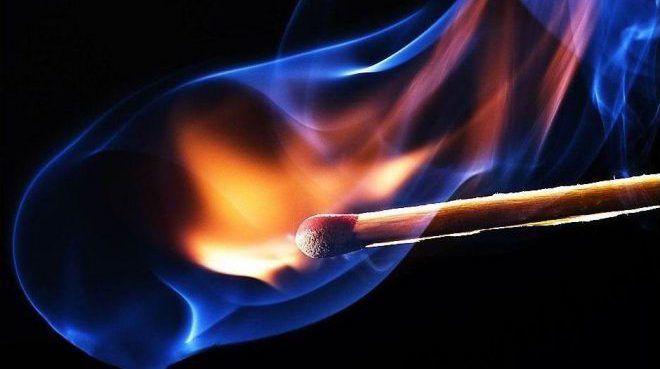
- The sound insulation properties of the 10 cm thick material are able to cope with the roar of a tractor without letting sound into the building.
- Foam glass is easy to install and resembles the technology of laying foam concrete. It is easy to cut with a hacksaw, it is light in weight - 150 kg per cubic meter.
- The safety of foam glass in sanitary terms is another advantage, since its environment is unsuitable for the proliferation of microorganisms, it does not emit toxic volatile substances and can be used for insulation of children's institutions and hospitals.
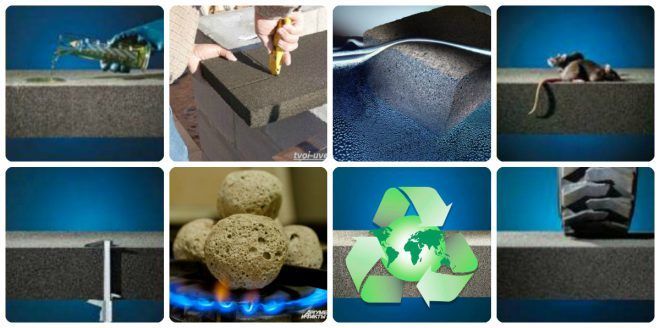
These qualities make foam glass a new generation of insulation, with high ergonomics and safety, since environmental friendliness is the motto of construction over the last decade.
Advantages
The advantages of foam glass include:
- Non-erosiveness . There are no soluble elements in foam glass. Nothing in it can be washed away by water.
- Immune to temperature fluctuations . Expanded foam “takes root” without problems in climate zones with the most extreme temperatures. In terms of its resistance to different temperatures, foam glass insulation can be compared with traditional materials from which load-bearing structures are made (steel, concrete, silicate and ceramic bricks). This is a guarantee that when installed on such a structure with foam glass, everything will be in order.
- No sagging or shrinkage due to good strength.
- You can use foam glass almost forever. Recent studies have shown that foam glass, which was used to insulate a municipal building in Pittsburgh, America, back in 1952, is fully serviceable after 65 years!
- Water leakage through foam glass is absolutely impossible, since it consists of closed cells. Even frozen water (which can damage granite and basalt) does not cause any harm to foam glass.
- The material does not oxidize , since it contains only higher oxides.
- Easy to install . Foam glass can do without complex fastenings, which often allow cold to pass through or become very hot and deformed.
- Foam glass can be reused after dismantling.
- High environmental friendliness makes it possible to use foam glass in the food industry, in bathhouses, swimming pools and cafes.

Flaws
Foam glass has fewer negative aspects than positive ones, but they also have their place, namely:
- High price category, since the material is the most expensive in comparison with other insulation materials. The cost is determined by the complex technological scheme for producing the material, in particular, firing of finished slabs is a fairly energy-intensive process.
- The greenhouse effect created by the slabs can provoke the development of fungus and mold on walls that are covered with foam glass. If you do not take care of high-quality sealing, the insulation will be of no use.
- Low impact resistance completes the shortcomings of foam glass. Having good rigidity and compressive strength, the material cracks from a strong impact and no longer serves as insulation when destroyed.
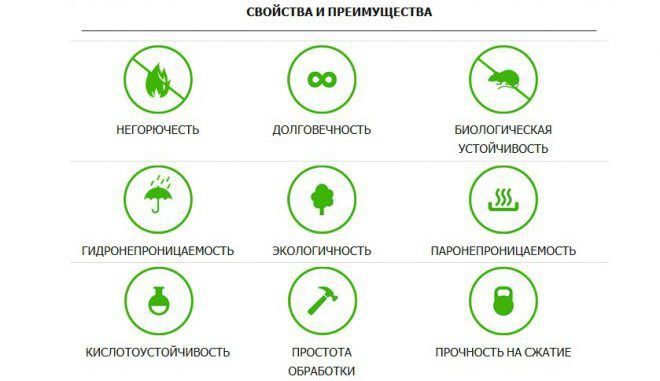
However, with proper installation and careful handling, foam glass will last quite a long time.
Advantages and disadvantages
Let's start with the advantages; foam glass has a lot of them:
- Moisture resistance. In fact, foam glass is a huge number of glass bubbles soldered together. Moisture is simply unable to penetrate into a sealed bubble. The only place where moisture can get in is in the upper layers of the slab bubbles. But this surface makes up less than 2% of the total volume of the slab. In addition, the cycle of thermal expansion and contraction of moisture in the bubbles does not harm the material in any way.
- Vapor tightness. The main amount of heat is carried out by steam in the air. This means that vapor permeability reduces the amount of heat loss. It also serves as the main drawback of the material, but more on that a little later.
- Biological resistance. Broken glass is often added to concrete or insulation to get rid of ubiquitous pests: rodents and insects. Here, the entire body of the insulation is glass, in which the spread of pests is in principle impossible.
- Environmentally friendly. At any possible temperature, the insulation does not emit harmful substances. Foam glass is absolutely safe for human health and is recommended for use in facilities with increased requirements for enclosing structures.
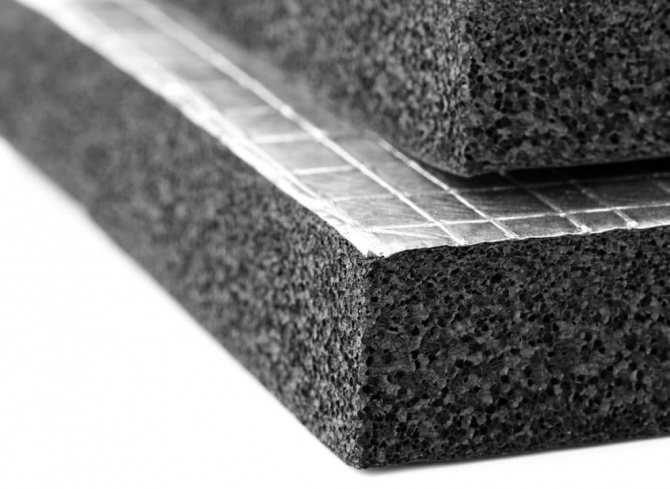
. There are also a number of disadvantages:
- Low strength. The insulation is not able to withstand physical impact. Therefore, it is more often used for internal insulation, which is not as effective as external insulation.
- Vapor tightness. This point is worth dwelling on in more detail. Vapor tightness is, on the one hand, good: less heat will escape from the room to the outside. On the other hand, vapor permeability prevents the passage of air from outside. And this is already a big minus. The fact is that infiltration in varying quantities is present in any room. And by infiltration we mean the passage of air through the walls into the house. Air penetrates especially actively in winter. Infiltration causes some moisture to enter the home. Good insulation has a thickness at which this moisture settles in the thickness of the insulation. And in the case of foam glass, moisture settles on the surface of the enclosing structure between the structural material and the insulation. This can lead to mold and mildew.
- Price. Perhaps this is the biggest drawback of this material. Any insulation must first of all be cheap. There are quite a lot of cheaper insulation options. It is because of this factor that foam glass still remains a material for luxury housing and expensive buildings with increased construction requirements.
How to choose correctly
[ads-pc-5]
There are several foam glass manufacturers on the domestic market. Each product must meet certain criteria for a quality insulation product.
The slabs in one batch must be of the same size, and the cellular structure of the slabs and blocks must be preserved - they should not merge with each other. Manufacturers of high-quality foam glass include a material passport, in which you can find out the vapor permeability of both slabs and granules. If there is no passport or it does not indicate the characteristics, it is better to refrain from purchasing.
To prevent the accumulation of condensation, it is recommended to calculate the optimal thickness of the slab so that the dew point is located in the slab and the outside walls are cooled to no more than +5 °C. Buy insulation only from trusted manufacturers, since poorly made insulation can worsen the condition of the walls without even performing its functions.
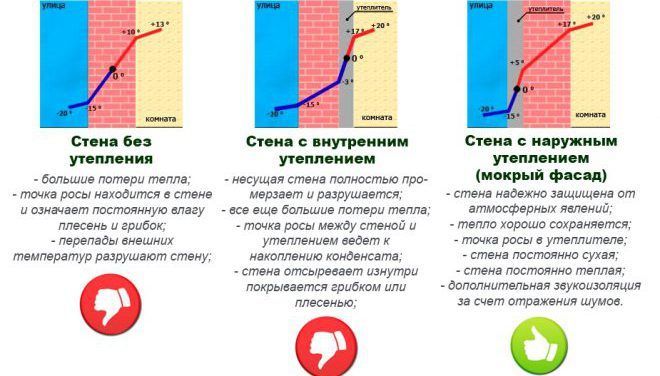
It is better to carry out insulation during construction of a facility than on a finished building. This is due to the fact that during construction it is possible to make thin and cold walls when insulation is planned in them. If the object has already been built, a thick layer of insulation will be needed to shift the dew point into it.
Rules for thermal insulation of a house with foam glass
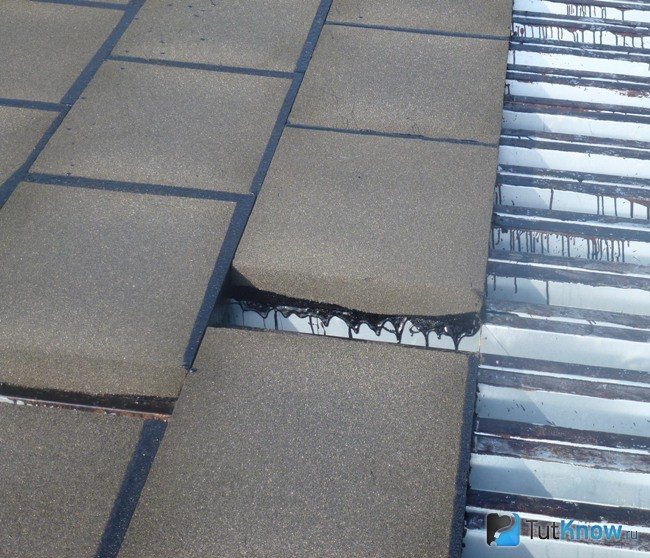
Foam glass insulation can be carried out in various rooms, but the methods of its fastening remain the same for all base surfaces and take into account certain rules:
- If the insulation is fixed using a special adhesive, it should be applied to both mating surfaces - foam glass and the base.
- When pasting an insulator onto an uneven surface that has small chips, depressions or cracks, it is advisable to apply the working mixture in splashes. Although this increases its consumption, it guarantees a reliable and durable fastening to the insulation.
- When thermally insulating a base made of wood, it is advisable to fasten the foam glass with special dowels. This is due to the fact that, with temperature fluctuations, lumber is capable of changing shape and size, so slabs rigidly fixed with glue may become deformed during the operation of the coating and cease to correspond to their main purpose.
- Before insulating a façade or other external walls with foam glass, special support profiles are installed around the perimeter of the building at the level of the building’s base, allowing the first row of slabs to be perfectly leveled and thereby ensuring the correct installation of the remaining covering elements. They are removed only after complete polymerization of the glue under the products of the bottom row.
- Foam glass slabs are always installed on walls from bottom to top, the same applies to inclined surfaces.
- All elements of the foam glass coating should be laid tightly to each other, and each overlying row should be located with some offset relative to the lower one to ensure suture ligation and the strength of the insulating layer.
- When using combined fastening of foam glass using glue and dowels, it is recommended to install the latter after pasting and drying of the composition.
- In the locations of openings and other similar structural elements, only solid slabs of foam glass should be installed.
Manufacturers
The first samples of the material were made in Russia, but today it is produced in different countries. The most popular following manufacturers:
- SAITAX is one of the largest foam glass manufacturing companies in Russia. The company's products are used for insulation of administrative buildings and government facilities.
- Pittsburgh Corning is an American insulation manufacturer with a half-century history of development. The company's facilities are also located in Russia. The insulation is sold under the FOAMGLASS brand and is used in both civil and industrial construction.
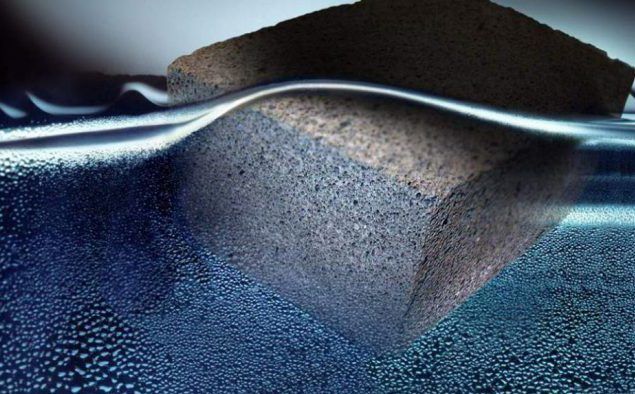
- Gomelsteklo is a Belarusian company of international level that supplies insulating materials to many countries around the world. Certificates and data sheets of materials are publicly available.
- ZSTM – Plant of construction thermal insulation materials, located in Ukraine. The plant produces insulating materials produced using unique technologies developed in research centers. At the moment, block and tile products are produced.
Pay attention to the history of the manufacturer, reviews about it and the availability of certificates - then the high cost will not become an obstacle and will pay off by reducing the cost of heating and air conditioning equipment in the house.

